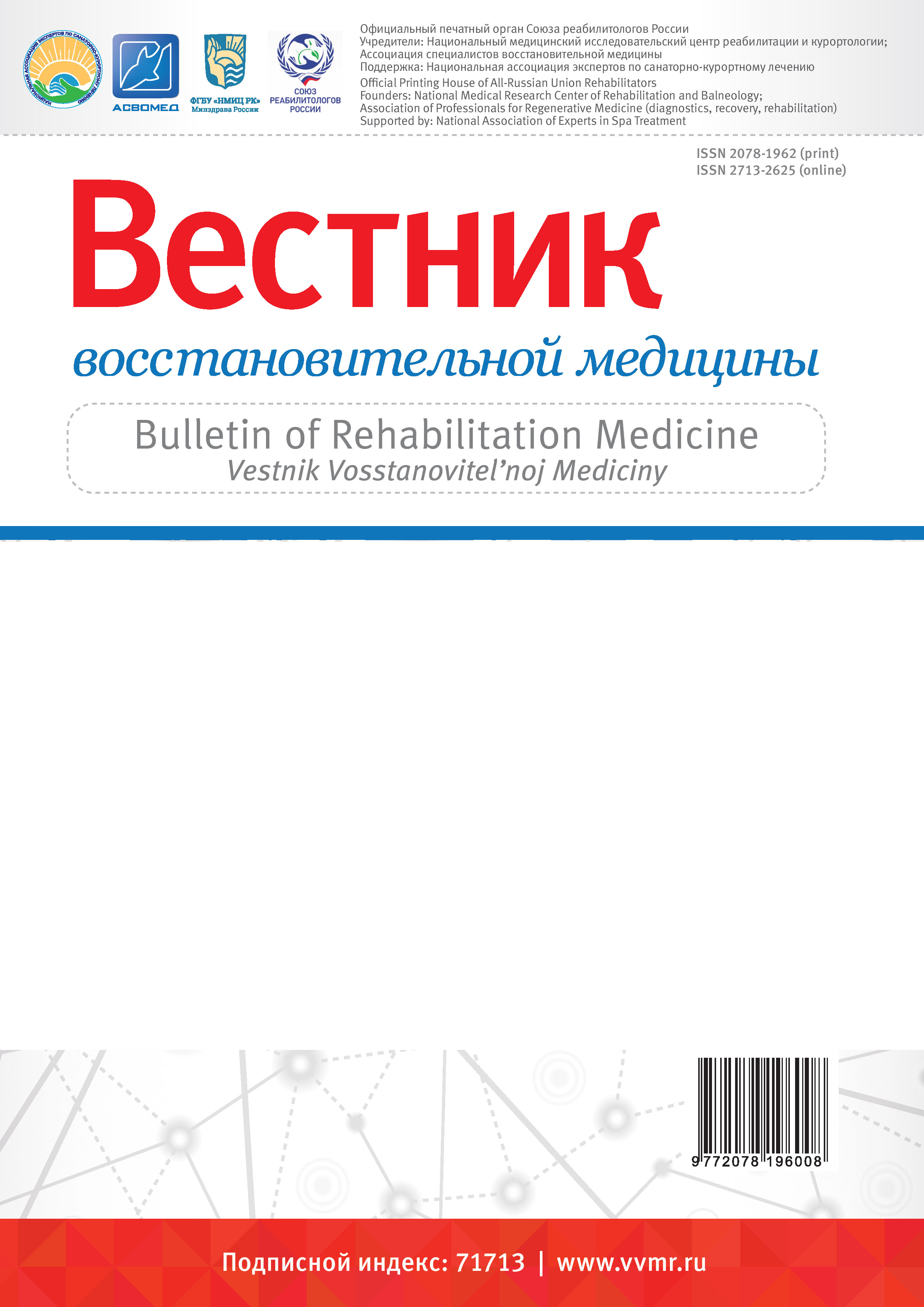More than half of the patients with spinal cord injury (SCI) requires a wheelchair, that is a key element for solving a large number of their domestic and social problems. It is known that pelvis position, neurological deficit, the height of wheelchair back and the type of cushion are the main factors affecting dynamic balance of the trunk in SCI patients. This factors determine the effectiveness of usage, together with motor capabilities of upper extremities, especially in patients with tetraplegia, when the loss of body balance is the main cause of falls from a wheelchair. Other complications are hand scuffs, carpal tunnel syndrome, pressure sores on the buttocks, fees and back, pain in the shoulder joints and neck. Measures against pressure sores include the use of special systems (cushion) to reduce pressure and complexes of physical exercises. For maximal congruence of the wheelchair for the patients needs, individual requisition is necessary, using a standardized anthropometry measure system in a sitting position. Keywords: wheelchair, spinal cord injury
wheelchair, spinal cord injury
1. Sonn U., Grimby G. Assistive devise in an orderly population studied at 70-76 years of age. Disability and rehabilitation,1994; 16(2): 85-93
2. Post M.W.M., vanAsbeck F.W.A., vanDijk A.J., Schrijvers A.J.P. Services for spinal cord injured: availability and satisfaction. Spinal Cord. 1997;35:109-115
3. Anderson K.D. Targeting recovery: priorities of the spinal cord-injured population. J Neurotrauma. 2004 Oct;21(10):1371-83
4. Nelson A.L., Ahmed S., Harrow J., Fitzger S., Sanchez-Anguiano A., Gavin-Dreschnack D. Fall-related fractures in persons with spinal cord impairment: a descriptive analysis. SCI Nurs. 2003;20:30-37.
5. Bernard P.L., Peruchon E., Micallef J.P., Hertog C., Rabischong P. Balance and stabilization capability of paraplegic wheelchair athletes. J Rehabil Res Dev. 1994;31:287-296
6. Cooper R A. Wheelchair selection and configuration, Springer Publishing Company, 1998
7. Bolin I., Bodin P., Kreuter M. Sitting position Posture and performance in C5 ± C6 tetraplegia Spinal Cord (2000) 38, 425 -434
8. Sprigle S., Wootten M., Sawacha Z., Thielman G. Relationships among cushion type, backrest height, seated posture, and reach of wheelchair users with spinal cord injury. J Spinal Cord Med. 2003 Fall;26(3):236-43
9. Frost S., Mines K., Noon J., Scheffler E., Stoeckle R.J. Wheelchair Service Training Package - Reference Manual for Participants - Intermediate Level. World Health Organization, Geneva. 2013
10. Mendes PVB, Gradim LCC, Silva NS, Allegretti ALC, Carrijo DCM, Cruz DMCD. Pressure distribution analysis in three wheelchairs cushions of subjects with spinal cord injury. Disabil Rehabil Assist Technol. 2019 Aug;14(6):555-560. doi:https://doi.org/10.1080/17483107.2018.1463399. Epub 2018 Apr 18.
11. Gil-Agudo A, De la Peña-González A, Del Ama-Espinosa A, Pérez-Rizo E, Díaz-Domínguez E, Sánchez-Ramos A. Comparative study of pressure distribution at the user-cushion interface with different cushions in a population with spinal cord injury. Clin Biomech (Bristol, Avon). 2009 Aug;24(7):558-63. doi:https://doi.org/10.1016/j.clinbiomech.2009.04.006. Epub 2009 May 17.
12. Sonenblum SE, Vonk TE, Janssen TW, Sprigle SH. Effects of wheelchair cushions and pressure relief maneuvers on ischial interface pressure and blood flow in people with spinal cord injury. Arch Phys Med Rehabil. 2014 Jul;95(7):1350-7. doi:https://doi.org/10.1016/j.apmr.2014.01.007. Epub 2014 Jan 27.
13. Aissaoui R., Lacoste M., Dansereau J. Analysis of sliding and pressure distribution during a repositioning of persons in a simulator chair. IEEE Transactions on Neural Systems & Rehabilitation Engineering. 2001;9(2):215-224
14. Hobson D.A. Comparative effects of posture on pressure and shear at the body-seat interface. Journal of Rehabilitation Research & Development. 1992;29(4):21-31
15. Jan Y-K., Jones M.A., Rabadi M.H., Foreman R.D., Thiessen PhA Effect of Wheelchair Tilt-In-Space and Recline Angles on Skin Perfusion Over the Ischial Tuberosity in People With Spinal Cord Injury Arch Phys Med Rehabil. 2010, Nov; 91(11): 1758-1764. doi:https://doi.org/10.1016/j.apmr.2010.07.227
16. Boninger ML, Baldwin M, Cooper RA, Koontz A, Chan L. Manual wheelchair pushrim biomechanics and axle position. Arch Phys Med Rehabil. 2000 May;81(5):608-13.
17. World Health Organization (WHO) Guidelines on the Provision of Wheelchairs in Less-Resourced Settings. Available at: www.who.int/disabilities/publications/technology/ wheelchairguidelines/en /2008.
18. Tu C-J, Liu L, Wang W, Du H-P, Wang Y-M, Xu Y-B, Li P. Effectiveness and Safety of Wheelchair Skills Training Program in Improving the Wheelchair Skills Capacity: A Systematic Review. Clin Rehabil. 2017; 31:1573-1582.
19. Sonn U., Grimby G. Assistive devise in an orderly population studied at 70-76 years of age. Disability and rehabilitation,1994; 16(2): 85-93
20. Post M.W.M., vanAsbeck F.W.A., vanDijk A.J., Schrijvers A.J.P. Services for spinal cord injured: availability and satisfaction. Spinal Cord. 1997;35:109-115
21. Anderson K.D. Targeting recovery: priorities of the spinal cord-injured population. J Neurotrauma. 2004 Oct;21(10):1371-83
22. Nelson A.L., Ahmed S., Harrow J., Fitzger S., Sanchez-Anguiano A., Gavin-Dreschnack D. Fall-related fractures in persons with spinal cord impairment: a descriptive analysis. SCI Nurs. 2003;20:30-37.
23. Bernard P.L., Peruchon E., Micallef J.P., Hertog C., Rabischong P. Balance and stabilization capability of paraplegic wheelchair athletes. J Rehabil Res Dev. 1994;31:287-296
24. Cooper R A. Wheelchair selection and configuration, Springer Publishing Company, 1998
25. Bolin I., Bodin P., Kreuter M. Sitting position Posture and performance in C5 ± C6 tetraplegia Spinal Cord (2000) 38, 425 -434
26. Sprigle S., Wootten M., Sawacha Z., Thielman G. Relationships among cushion type, backrest height, seated posture, and reach of wheelchair users with spinal cord injury. J Spinal Cord Med. 2003 Fall;26(3):236-43
27. Frost S., Mines K., Noon J., Scheffler E., Stoeckle R.J. Wheelchair Service Training Package - Reference Manual for Participants - Intermediate Level. World Health Organization, Geneva. 2013
28. Mendes PVB, Gradim LCC, Silva NS, Allegretti ALC, Carrijo DCM, Cruz DMCD. Pressure distribution analysis in three wheelchairs cushions of subjects with spinal cord injury. Disabil Rehabil Assist Technol. 2019 Aug;14(6):555-560. doi:https://doi.org/10.1080/17483107.2018.1463399. Epub 2018 Apr 18.
29. Gil-Agudo A, De la Peña-González A, Del Ama-Espinosa A, Pérez-Rizo E, Díaz-Domínguez E, Sánchez-Ramos A. Comparative study of pressure distribution at the user-cushion interface with different cushions in a population with spinal cord injury. Clin Biomech (Bristol, Avon). 2009 Aug;24(7):558-63. doi:https://doi.org/10.1016/j.clinbiomech.2009.04.006. Epub 2009 May 17.
30. Sonenblum SE, Vonk TE, Janssen TW, Sprigle SH. Effects of wheelchair cushions and pressure relief maneuvers on ischial interface pressure and blood flow in people with spinal cord injury. Arch Phys Med Rehabil. 2014 Jul;95(7):1350-7. doi:https://doi.org/10.1016/j.apmr.2014.01.007. Epub 2014 Jan 27.
31. Aissaoui R., Lacoste M., Dansereau J. Analysis of sliding and pressure distribution during a repositioning of persons in a simulator chair. IEEE Transactions on Neural Systems & Rehabilitation Engineering. 2001;9(2):215-224
32. Hobson D.A. Comparative effects of posture on pressure and shear at the body-seat interface. Journal of Rehabilitation Research & Development. 1992;29(4):21-31
33. Jan Y-K., Jones M.A., Rabadi M.H., Foreman R.D., Thiessen PhA Effect of Wheelchair Tilt-In-Space and Recline Angles on Skin Perfusion Over the Ischial Tuberosity in People With Spinal Cord Injury Arch Phys Med Rehabil. 2010, Nov; 91(11): 1758-1764. doi:https://doi.org/10.1016/j.apmr.2010.07.227
34. Boninger ML, Baldwin M, Cooper RA, Koontz A, Chan L. Manual wheelchair pushrim biomechanics and axle position. Arch Phys Med Rehabil. 2000 May;81(5):608-13.
35. World Health Organization (WHO) Guidelines on the Provision of Wheelchairs in Less-Resourced Settings. Available at: www.who.int /disabilities/publications/technology/ wheelchairguidelines/en /2008.
36. Tu C-J, Liu L, Wang W, Du H-P, Wang Y-M, Xu Y-B, Li P. Effectiveness and Safety of Wheelchair Skills Training Program in Improving the Wheelchair Skills Capacity: A Systematic Review. Clin Rehabil. 2017;31:1573-1582





